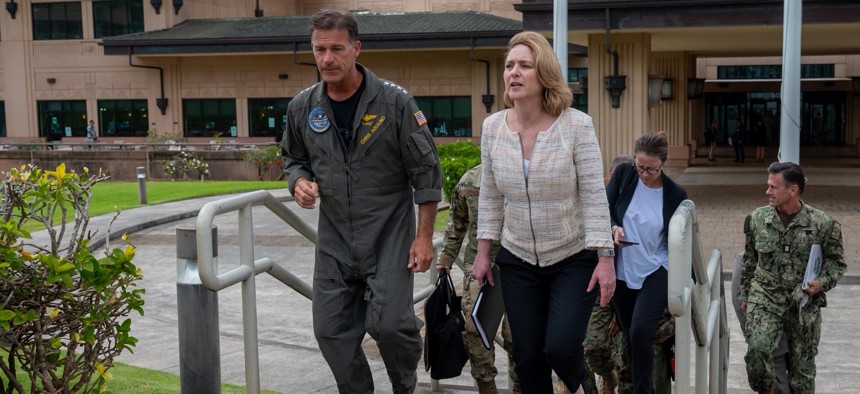

Adm. John Aquilino and Deputy Defense Secretary Secretary Kath Hicks tour technology displays at INDOPACOM headquarters in Hawaii. DEPARTMENT OF DEFENSE / SGT. JOHN RIGHT
As China ramps up military activity, Pentagon looks to accelerate networked warfare tech and exercises
The U.S. is working to retain “decision advantage” in the Pacific, in anticipation of a possible Chinese invasion of Taiwan.
JOINT BASE PEARL HARBOR-HICKAM, Hawaii—The Pentagon is accelerating the development of new breakthrough technologies and ramping up exercises with regional partners as it prepares for an anticipated increase in aggressive military activity from China in the South China Sea.
The moves are designed to deter a Chinese invasion of Taiwan, which many experts believe is coming by 2027.
“Up until about maybe a year and a half ago, we never had a routine, consistent presence of the [Chinese] navy east of Taiwan. Now, they’re there all the time,” one senior defense official told Defense One. Those sorts of stunts from China aren’t just to show force, the official said, but also an effort to exhaust Taiwanese defense capabilities and ability to respond.
“It’s just wearing out Taiwan’s air force for the air stuff and the navy for all of this contiguous presence, because you can’t really let it go unchallenged,” the U.S official said. “The Chinese have a lot more airplanes and a lot more capability to fly all the time. It’s just running the poor Taiwanese air force into the ground.”
China’s steadily increasing military maneuvers around Taiwan are, in part, a response to increased U.S. political interaction with Taiwan, including then-U.S. House speaker Rep. Nancy Pelosi’s, D-Calif., visit to Taipei in August 2022 and Taiwan President Tsai Ing-wen’s meeting with current U.S. House Speaker Kevin McCarthy, R-Calif., in April.
“Between the beginning of August and the end of the year, I want to say that we’re at about 200 centerline crossings,” or instances where Chinese vessels crossed into Taiwanese waters, the senior U.S. official said. “So a clear and deliberate escalation…as a signaling tool.”
The official expressed concern that China may attempt another bullying naval maneuver around Taiwan later this summer, in response to continued outreach to Taiwan from U.S. lawmakers.
“Members of Congress travel when Congress is in recess,” the official said. “So it looks like an intentional pile-on that’s, in fact, just driven by the Congressional calendar and August recess.”
In 2021, Adm. Philip Davidson, then-commander of U.S. Indo-Pacific Command, said China could make a play for Taiwan by 2027—the year by which China’s President Xi Jinping has ordered his military to be prepared for a possible invasion. Current INDOPACOM head Adm. John Aquilino has neither endorsed nor refuted the date, at least not publicly.
But an invasion is far from a certainty, according to the official who spoke to Defense One, especially if President Xi can absorb Taiwan politically with no bloodshed. Still, that 2027 time frame looks like the most attractive date for an invasion based on a variety of factors, experts say. Perhaps the most important is that China’s weapon modernization efforts are scheduled to reach a key maturity point then—about two years before Taiwan completes similar efforts designed to make an invasion too costly for China to attempt.
To better deter that potential Chinese invasion, the Defense Department is accelerating key efforts in joint all-domain command and control, or JADC2, in the region, and INDOPACOM is working to increase the number and scope of its exercises and to bring in more partners to present a broad unified front against Chinese aggression.
Additionally, the U.S. Air Force is in the midst of its largest ever mobility exercise in the Pacific, practicing how it would move troops and supplies around the expansive region during a war with China.
Military leaders often describe JADC2 in terms of a vision for the later half of the decade, when massive data flows to artificial intelligence agents will enable commanders to collapse the time it takes to identify targets and dispatch them with the most appropriate weapon on the battlefield, regardless of whether that weapon belongs to the Navy, Army, or Air Force, and whether if it’s a manned jet, drone, or a missile battery.
But Deputy Defense Secretary Kathleen Hicks, who is visiting military and defense officials in Hawaii this week, pushed back on the idea that JADC2 was a future endpoint.
“Some folks like to talk about JADC2 as though it’s far off and it’s not something we’re advancing every day,” she said.
Hicks has already launched a series of efforts to greatly speed up actual JADC2-enabling technologies to the battlefield. One effort, the Rapid Defense Experimentation Reserve, or RDER, uses reserve funds under the control of the undersecretary—$687 million in the current budget—to boost new technologies that have relevance to the joint force, rather than a specific service.
A sampling of those early technologies includes electronic warfare kits that can detect and emulate the radio or electronic signatures of a wide variety of ships, planes, etc. to convince adversaries to deploy scarce resources to investigate phantom jets and tanks. Another early RDER prototype viewed exclusively by Defense One allows operators to pass data through unsafe IT networks, a major concern in the broader region as China has a growing share of key portions of telecommunications infrastructure even in nations friendly to the United States.
Hicks said efforts like RDER are critical to making joint, all-domain warfighting a reality as soon as possible.
A second senior defense official outlined a number of key mission threads that RDER will address, including integrated air and missile defense, surface warfare, distributed re-supply, long-range fires and logistics under adverse enemy conditions.
INDOPACOM also wants to accelerate key technology areas in order to run more exercises with service branches and partner nations. One effort is a new mission partner environment, envisioned as a kind of virtual destination where INDOPACOM commanders can use data from all the services and from allies, such as the Philippines, much more quickly. One defense official who spoke to Defense One said INDOPACOM plans to conduct its first demonstrations of the capability in September with Japan. A demonstration with Australia would follow soon after.
Another effort, the Pacific Multi-Domain Training and Experimentation Capability, will significantly increase the number of virtual exercises INDOPACOM can conduct and will allow a more diverse set of players to participate in real wargames virtually. For instance, ship crews could practice how they might respond to a certain scenario alongside other air, land, sea, and space forces without having to physically move a ship.
“A lot of what we’re spending time on here is about this decision advantage issue of how you bring information at speed and scale to make a difference on the battlefield, and that is where, if you’re in INDOPACOM, you may have a particular way you want to manage that visualization of the theater, and we want to enable that,” Hicks said.
While the United States is driving these technology efforts, officials said partner nations want to play a role too, particularly in a more robust schedule of joint exercises as they seek to counter China’s illegal fishing and bullying by the Chinese coast guard.
“Now they are coming to us,” a senior military official said.

A child watches a mock launch of a carrier rocket at the China Space Science and Technology Exhibition “Tiangong Pursuing Dreams” at the Yantai Museum in Yantai, East China’s Shandong province, May 18, 2023. SU YANG / CFOTO / FUTURE PUBLISHING VIA GETTY IMAGES
China’s Commercial Space Ventures Pose A Variety of Threats, DOD Officials Say
Officials worry China may do for commercial-space capabilities what it did for cheap telecom equipment.
China has ramped up its space mission, with plans to surpass 70 launches—commercial and military—this year. And while the Pentagon has been vocal about the clear military threat China’s rocket program poses to U.S. satellites, officials say China’s growing commercial space activity also poses a threat.
“There’s been a long debate about state-owned enterprises, and really the viability of a separate commercial sector given the laws that are in place in the PRC, and the necessity to maintain a relationship and frankly, exposure to the PRC leadership in particular, on what’s going on and those commercial enterprises,” said Maj. Gen. David Miller, the Space Force’s director of operations.
The U.S. must presume a Chinese satellite is a threat regardless of whether it is commercial or military, he said. The most obvious concerns are the potential threats posed by satellite weapons in space, and by Chinese launch technology to destroy U.S. satellites. Less obvious, but still concerning, are China and Russia’s future market shares in space-based services like satellite communications, position navigation and timing, and space-based images.
Consider the role unclassified commercial space imagery played in preparing the world for Russia’s invasion of Ukraine: Firms like Maxar and Planet Labs provided open-source information that shaped public opinion, allowing for the swift passage of sanctions packages that have undermined Russia’s war effort.
China is also getting into the Earth-imaging business, as evidenced by a new launch in December. Given Chinese abilities in generative adversarial networks and other AI tools that lend themselves to image manipulation, does that pose an information warfare threat, given how important satellite images have become to public understanding of geopolitical crises?
That’s “something that we not just think about, but we look at—and it’s not just Russia, China,” John Huth, defense intelligence officer for space and counterspace at the Defense Intelligence Agency told Defense One in an interview at DIA’s headquarters in June.
“I’ll say a bigger concern on the economic side is, is it fair competition, right? If all your companies are state sponsored, that kind of gives you a leg up. Where it’s not a true commercial market,” he said, referring to the Chinese model of using the government to fund “private” enterprises that have both a commercial and a military application. That sort of model gave China an advantage in selling telecommunications equipment and services for 5G, which it’s now using to build partnerships in AI with countries that don’t necessarily share China’s geopolitical interests but do like access to cheap technology.
“China has been trying to sell services to other countries, whether it be [communications] or [precision, navigation, and timing.] Other things, you know, as part of their Belt and Road Initiative…So they have had some successes with other countries in pulling them in, if you will, and in some cases, providing some upfront investment to pull them in. And we’ll see over time how well those investments pan out for those countries,” Huth said.
In the future, on-orbit serving—using satellites to refuel, repair, or move other satellites—will be another area where commercial and military activity blur. It’s also an area in which the Chinese government has invested heavily and is already seeing returns.
Still, U.S. entrepreneurs can play a growing competitive role, as long as the U.S. government can help them become more established, Vice Chief of Space Operations Gen. David Thompson said during the recent Defense One Tech Summit.
“I think there’s some good capability there, and more coming. I firmly believe in the force design that our space warfighting analysis center has just completed, that we’ve worked with the other services, worked with combat commanders and others…That is an investment area we in the Space Force need to address as we go into future budgets. And so there’s not enough of it there yet. We’ve thought very carefully about the types of services required.”
NEXT STORY: Army Mulls New Tool to Track Soldier Readiness


